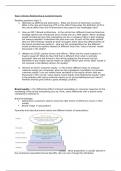Topic 5 Brand, Relationship & Customer Equity
Reading questions topic 5:
1. (Dwivedi ea 2009) brand extensions - What are drivers of extension success?
What is the role and meaning of fit in this effect? How does the definition of fit in
this article differ from the fit dimensions discussed in the knowledge clips?
2. (Hsu ea 2017) Brand architecture - In the article four different brand architecture
strategy options are introduced and a mixed one as a fifth option. Which strategy
would normally be the most interesting one for a company? Why is that strategy
not always possible? Understand the pros and cons of each of the other options.
How are their findings related to what managers think about the effectiveness of
the brand architecture options? . How are the considerations for the different
brand architecture options related (of different from) the ‘rules of thumb’ model
discussed in the slides?
3. (Watson ea 2015) Loyalty drivers and effects - What are the usual suspects in
loyalty research? What do they find that is different from what is normally
assumed? How are the drivers in this article related to the drivers that are
identified in the model used by Hsieh ea (2005)? Which part of this latter model is
not covered in the Watson drivers for loyalty?
4. (Silveira ea 2017) Customer equity - In the article different ways to measure
customer equity are compared. what are the ingredients (variables) to calculate
customer equity? can you relate these variables to the equity drivers that we
discussed in this course: value equity, brand equity and relationship equity? what
is the problem with using customer equity as an accountability/success metric?
Portfolio brands give brands a good strategic position.
Brand equity = the differential effect of brand knowledge on consumer response to the
marketing of the brand (everything you do, think, share differently with a brand name
compared to without it).
Brand knowledge:
Awareness (customers need to have the right frame of reference of you in their
minds)
Brand image associations
Pyramids that describe brand values and different levels of associations:
Value proposition is usually placed in
the emotional rewards/functional benefits. We can only change the attributes.
,Personalities: sincerity, excitement, competence, sophistication, ruggedness.
Strong brands have associations that are SFU (strong, favourable, unique)
And congruent with brand concept.
Harley Davidson could stretch do darts, but perfume becomes hard. Extensions can
reinforce your brand, but if you go too far, your brand equity can dilute.
Brand dilution is when a company's brand equity diminishes due to an unsuccessful
brand extension, which is a new product the company develops in an industry that they
don't have any market share in.
Value hierarchy
Higher positioned brands have more room ‘to play’
o E.g. Bertolli olive oil: Italian way of life.
However: any positioning should be substantiated by the values below, everything
needs to be proving the same thing.
Extension success and brand success
Most important for extension and brand success:
1. Perceived fit
2. Parent brand image
3. Brand extension attitude
A fit on product level and on brand level.
Horizontal extension
Line extensions vs. brand extensions
Line = similar product category vs. brand = similar brand values.
Going outside your category, says the product fit will be intrinsically low.
Fit vs relevance in category
Kellogg’s cereals introduced an orange juice, Campbell’s pasta sauce introduced ketchup,
these brands might have a fit, but it doesn’t have any relevance for the customer.
You also have to be in line with competitors (point-of-parity) so they accept you as a
detergent (so they co-branded with Robijn) and you need a point-of-difference, in what
way you are different than your competitor.
, Continuum in brand architecture options:
Sub-brands: 50/50 option, I have new product with name but the mother brand
needs to be on the product as well
Endorsed brand: I give the brand its own name, but you make a small link to the
mother company
Rule of thumb activity distance
New flavour; lays with cheese flavour, you want to target the same group branded
house
Sony, New product, new associations, new target group, new category than mother
brand, but want to play on same mother brand values sub-branding
Different options within same category, however, with (vertical extensions) mother
company you cannot target the target group, for example when you want to go into the
luxury group, you need the functional associates (point of parity) Alexis & Toyota,
customers need to know you are good at making car, you use functional associations to
make people trust you, but you need a new emotional shell, new entrance endorsed
branding
Articles asks which option is financially more promising:
Returns:
Cost reduction: highest on left side of continuum
o Economies of scale in marketing
o Administration & operation costs efficiencies
o Low cost for new introduction
Revenue enhancement: highest on right side (target very specific groups and
get additional revenues from these new groups or from new brands that your
mother brand cannot carry)
o Added sales through new segments
o Improved innovation success
o Prospects for new extensions and customised offerings
Idiosyncratic risks:





